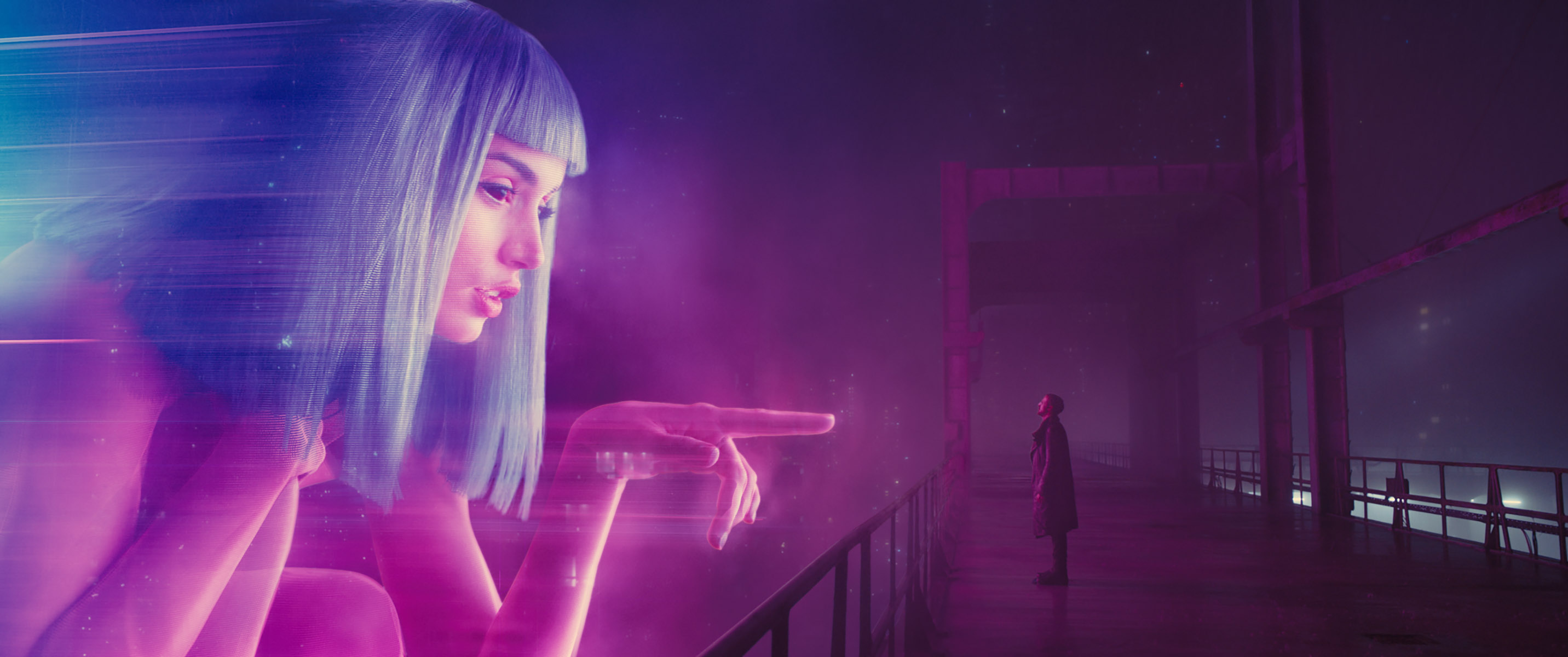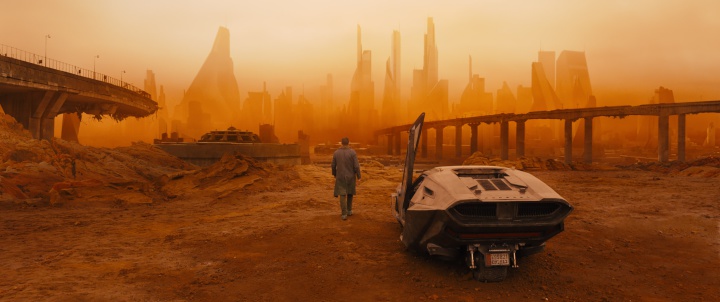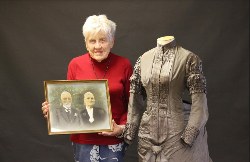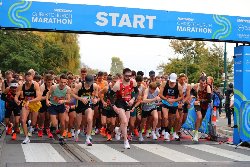Howard Davis Review: Blade Runner Redivivus

When Ridley Scott's innovative, neo-noir, sci-fi flick
Blade Runner was originally released in 1982, at a
cost of over $45 million, it was a commercial bomb. Reissued
in a Director's Cut format a decade later, it was rated as
one of the greatest movies of all time. Thirty-five years
later, the long-awaited $185 million sequel lasts an epic
two hours and forty-three minutes (including an eleven
minute end-credit sequence) and must be seen on the biggest
screen available for its sheer scale to be fully
appreciated. In the early stages of development, Scott
himself was lined up to direct, but as the movie approached
pre-production, he announced he would only be involved as a
producer. No specifics were given about why he dropped out
of directing, but a report emerged in 2014 that the
Prometheus sequel Alien: Covenant had been
delayed because Scott planned to helm Blade Runner
2049 after The Martian, which was in production
at the time. Now, however, it seems things happened the
other way round - Scott's commitment to Alien:
Covenant may have forced him to step aside from
directing Blade Runner 2049.
Michael Green and Hampton Fancher (co-writer of the original Blade Runner, based on Philip K Dick's novel Do Androids Dream of Electric Sheep?) wrote the screenplay. When Fancher was first approached, he agreed to a 110-page novella format mixed with dialogue and told them to leave him alone after that. In an interview for Collider magazine, French-Canadian director Denis Villeneuve commented that "Hampton Fancher, Ridley Scott, and Michael Green did a fantastic job on the screenplay ... And I felt that it made sense to me and I had the Ridley Scott blessing. But ... I hesitated massively. It took me a lot of time to say yes." The premise has been accused of lacking originality since it picks up the thread again after thirty years, with LAPD Officer K searching for Rick Deckard, who has mysteriously disappeared. Similarly, in TRON: Legacy Sam Flynn searches for his father who has been missing for twenty-seven years; and in Star Wars: The Force Awakens Rey, Finn, and Hans Solo try to track down Luke Skywalker who has also vanished.
Villeneuve admitted he was initially resistant to working on a sequel because he felt it would violate his vivid memories the original: "It's more than nervous, it's a deep fear. I mean when I heard that Ridley Scott wanted to do another movie in the Blade Runner universe, at first my reaction was that it's a fantastic idea, but it may be a very bad idea. I'm among the hardcore fans of Blade Runner. It's one of my favorite movies of all time. It's a movie that is linked with my love and passion for cinema. I'm coming from a small town in Quebec where, at that time, there was no internet and the way to be in contact with movies were those American fan magazines like Fantastic Films and Starlog and I still remember the shock, the impact of seeing the first frames, the first pictures coming out of Blade Runner. Me and my friends were in awe … and the movie was such a strong cinematic experience."
However, after reading the screenplay (which both he and Harrison Ford have described as "one of the best" they have ever read), Villeneuve agreed to helm the project, especially as Ford was already involved: "To be very honest with you, Harrison was part of the project before I arrived. He was attached to it right from the start with Ridley. I met him and he's honestly one of the nicest human beings I've met and is one of my favourite actors of all time, so for me it's a lot of pleasure." Villeneuve was fully aware how loyal fans of the original might view the prospect of a sequel: "I know that every single fan will walk into the theatre with a baseball bat. I'm aware of that and I respect that, and it's okay with me because it's art. Art is risk, and I have to take risks. It's gonna be the biggest risk of my life but I'm okay with that. For me it's very exciting ... I've been dreaming to do sci-fi since I was ten years-old and I said 'no' to a lot of sequels. I couldn't say 'no' to Blade Runner 2049. I love it too much." Ultimately, Villeneuve said he signed on "because you don't want to cut and paste, otherwise there's no point. And at the same time you have to respect what was done, so you have to find the right equilibrium between being faithful to the first one and bringing something new at the same time that will make sense to the Blade Runner universe."
Since Scott toyed with multiple re-edits of Blade Runner over the years, it is fair to ask which version Villeneuve considered canonical. He has stated that his film follows on from the Final Cut version released in 2007, while also insinuating it is by no means a straightforward sequel: "The movie will be autonomous and at the same time there will be some link. The only thing I can say is I was raised with the original cut, the original version that Ridley doesn't like. That's the Blade Runner that I was introduced to at the beginning and that I loved for years, and then I must say that I appreciated the very last cut, the Final Cut version. So between all the different cuts, for me it's the first and the very last that I'm more inspired by."
Both films focus on a disenchanted cop who is tasked with tracking down and eliminating disobedient androids called replicants. Ever since Blade Runner was released, enthusiasts have been divided about whether or not Deckard is a human or really another replicant. Although Scott, Ford, and everyone else have offered their own thoughts, it is a question that was left open. Villeneuve coyly refused to say whether his film solves the engima: "The thing I must say is that I love mystery. I love shadows. I love doubts. I would just want to say to the fans that we will take care of that mystery. I will take care of it." The setting is once again a disfigured and rain-drenched Los Angeles, but thirty years further into the future. In the intervening decades, the climate has has gone berserk due to rampant pollution, turning LA into a desolate, desensitized, and chilly dystopia. "As much as the first movie had an atmosphere of constant rain, in this one it would be colder," commented Villeneuve. "You could say that the first movie was made by a man from London … and the second one was made by someone from Montreal … It's a world that is quite bleak and dark and claustrophobic, but I tried to find an equilibrium, with explosions of colour that would express some emotions and some themes. The colour yellow is very important in the movie and is linked with different aspects, story-wise."

The role of Officer K (a
limited-lifespan replicant whose task is to track down and
destroy those first-gen models who can live as long as
humans and are still illegally hiding out) was written
specifically for Ryan Gosling. K has a gorgeous, live-in, VR
girlfriend named Joi (Ana De Armas), with whom he thinks he
may be in love, even though he also assumes they are both
just constructed artifacts. Having discovered the skeleton
of a dead replicant, K embarks on a mythical quest, with
both his boss Lieutenant Joshi (an androgynous Robin Wright)
and the super creepy Niander Wallace (Jared Leto) clearly
curious about what he may uncover. To keep tabs on K,
Wallace delegates his inscrutable assistant Luv (Sylvia
Hoeks), who has a disconcerting habit of crying without her
face showing any emotion at all. In an interview for Dutch
magazine Algemeen Dagblad, Hoeks explained how her
hair was dyed black to give her "an Asian appearance … I
became the Japanese version of myself. My best friend and I
even started to greet each other in Japanese."
The Tyrell Corporation that once manufactured the replicants, whose Spartacist uprising was the original theme, has been consolidated into an agribusiness empire owned by Wallace, a sightless grotesque who broods on how to create replicant-workers on a scale sufficient for his imperial plans. David Bowie was apparently Villeneuve's first choice for the role, but died before the start of the production. Instead, it went to Leto, who was introduced to Villeneuve by director of Dallas Buyers Club Jean-Marc Vallée, and traveled to Budapest in September 2016 to shoot his scenes which were wrapped in under two weeks. While filming, he decided to fit himself with opaque contact lenses that completely restricted his vision in order to help him get into the mindset of playing a blind character.
This marking of vision is a recurrent, self-reflexive theme throughout the film, with imagery of retinal scanners and virtual reality advertising constantly bringing into question what is real and what is not. One haunting scene involves K standing on an overpass in the pouring rain, rapturously gazing at (and being gazed at by) an immense holographic image of the naked and ever-seductive Joi. "The image of the eye was very important to Ridley Scott's universe and those elements are in 2049 as well," Villeneuve has observed. "There's the cliche that the eyes are windows to the soul, and we're dealing with replicants who don't have a soul." When Deckard is offered what seems like a perfect replacement for the original Rachael, he rejects her, commenting tersely "her eyes were green."
K’s aerial forays in his battered squad-car/mini-plane (known as a 'spinner') are highly kinetic, especially the sequence in which he is shot down over the vast scrap metal sink of San Diego by a low-tech harpoon gun. Each time K completes a mission, he is taken to an interrogation module where he is subjected to a fierce call-and-response dialogue in which he has to respond to key words to check his humanoid/android identity balance. It is a strangely bizarre and compelling form of Clockwork Orange de-programming, yet persuasively normal in this alienated universe. It all leads to a final, faintly Freudian showdown with Deckard himself (played once again with haggard misanthropy by Ford), in an orange-tinted, irradiated, post-apocalyptic Las Vegas.
Villeneuve's visually staggering film is a pitiless, gigantic spectacle that is alternately tragic, erogenous, and slyly satirical. It plays a poignant theme and variations on a plaintive, underlying melody of desideratum, its cortex-splintering imagery triggering not only spine-tingling sensations of awe and wonder, but also a kind of ecstatic despair at the environmental detritus left behind by homo sapiens. The poorest residents inhabit a desolate cityscape of hallucinatory insanity, living in cramped boxes inspired by Hong Kong's low income housing units called 'coffin cubicles.' It is crammed with spectral VR avatars, flashing corporate logos (playfully including the obsolete PanAm), and a plethora of flickering neon signs in a conglomerate linguistic soup worthy of Anthony Burgess at his most dyspeptic. "Cityspeak" includes bits of broken Russian, Japanese, Hindi, and Korean. When K eventually discovers Deckard holed up in his burnt-out hotel, the sign above the entrance reads, ironically and in reverse, "Haeng Un" - Korean for 'Good Luck.'
There are subtle allusions to some of the films inspired by Blade Runner, including James Cameron’s The Terminator, Steven Spielberg’s AI, Christopher Nolan’s The Dark Knight, Andrew Stanton’s WALL_E, and Spike Jonze’s Her. But the cinematic references also reach further back, to the hotel-bar and spaceship in Stanley Kubrick's 2001 and the desolate final moments of Planet of the Apes. The wonderful Eddie Olmos is allotted a all too brief cameo reprising his enigmatic role as Gaff, now in a nursing home, but still wearing his bow tie and deftly folding his origami figurines. But Sean Young, whose career nose-dived after playing Rachael in the original Blade Runner, was not asked to return. After suggesting that fans of the original film should boycott the sequel if she wasn't involved, she later told The Guardian, "I saw Ridley a month ago, and not a peep was uttered from his mouth about it, and so I left it alone."
The sequel makes it quite clear why this wouldn't have worked. It also replaces Blade Runner's intimate, downbeat, noir qualities in favour of a much more overbearing, monolithic, and oppressive scenario. Joe Walker's finely-paced editing preserves the original's sedately controlled andante tempo, while Hans Zimmer and Benjamin Wallfisch's synth-heavy score is gaunt and angular, like the noise of machinery constantly grinding in the background, a pulsating nod to Vangelis, with the volume amped way up. The extraordinarily detailed production design by Dennis Gassner produces a panoply of oneiric imagery, reminiscent of some incredibly lurid dream. Roger Deakins' cinematography is equally stunning, his gliding Steadicam slowly revealing a minatory underworld, washed in garish, expressionist wedges of glutinous electric light, and cold, metallic interiors slashed with harsh horizontal lines. It is a portentous vision, the malevolence of which is only intensified by Theo Green's groaning and rumbling sound design. Costume designer Renee April and set decorator Alessandra Querzola have retained the original's disarmingly anachronistic mixture of retro cars and bicycles, cocktail decanters and umbrellas, and cyberpunk glamour/grunge wardrobe. All these superb technicians clearly deserve Oscar nominations.
The narrative arc of Blade Runner 2049 does take up seamlessly where the original tailed off, but it has received some criticism for surrendering its answers too easily. While the plot line of Blade Runner possessed a haunting inscrutability, maybe Sony thought such deliberate opacity would prove insufficiently commercial. This is the same sort of imbalance that has afflicted so many recent blockbusters, including Villeneuve's three previous offerings - Prisoners, Sicario, and Arrival: a script that doesn't quite manage to fully inhabit the looming structure in which it is housed. Compared to many recent comic books franchises, however, Blade Runner 2049 raises some heavy questions about the imminent destruction of the biosphere; how we create, distort, and manipulate images and memories; and the conflict between advanced technology and what it means to be truly human. Overall, Blade Runner 2049 is a spectacular cinematic offspring of its illustrious predecessor, proving Villeneuve to be a worthy beneficiary of Scott's generous bequest.
TRIVIA NOTES : European sci-fi magazine Métal Hurlant, considered a revolutionary iconic book during the 70s and 80s, inspired many writers and filmmakers, including Blade Runner. François Schuiten, one of the most influential artists behind Métal Hurlant, was production designer on Mars et Avril (2012). This sci-fi romance, which pays tribute to Métal Hurlant in many ways, was directed by Martin Villeneuve, younger brother of Denis.



 Tatai Aho Rau Core Education: Cyber Skills Programme For Tamariki Recognised At Māori Language Awards
Tatai Aho Rau Core Education: Cyber Skills Programme For Tamariki Recognised At Māori Language Awards Waitaha Kapa Haka: Waitaha-South Island Kapa Haka Celebrates 60th Anniversary
Waitaha Kapa Haka: Waitaha-South Island Kapa Haka Celebrates 60th Anniversary Braden Currie: Sets Sights On The Ironman North American Championships In Texas
Braden Currie: Sets Sights On The Ironman North American Championships In Texas Whanganui Regional Museum: Historic Wedding Dress Unveiled, A Piece Of Marton’s Heritage
Whanganui Regional Museum: Historic Wedding Dress Unveiled, A Piece Of Marton’s Heritage Donovan Ryan: Local Runner Takes Out Frontrunner Christchurch Marathon
Donovan Ryan: Local Runner Takes Out Frontrunner Christchurch Marathon University of Auckland: Tributes Flow For Much Loved Pacific Leader Melegalenu’u Ah Sam
University of Auckland: Tributes Flow For Much Loved Pacific Leader Melegalenu’u Ah Sam